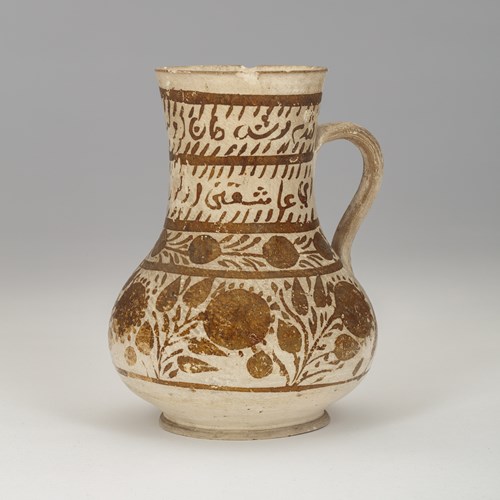Marketplace
An Indian Mail Helmet
An Indian Mail Helmet
Period 16th or 17th century
Medium mail, Steel
Dimension 42 cm (16¹/₂ inches)
This steel helmet comprises several converging plates linked by rivetted mail. Typically, on most helmets, the bowl is made of a single, continuous piece of metal. However, in this instance, eight triangular steel plates with holes on the sides are held together to make the bowl. A circular disc at the top holds all the plates together. This is concealed with a fluted bud-shaped finial. Fitted at the front with a rectangular staple is a sliding crescent shaped faceguard.[1] Composite helmets like this would have been easier to manufacture than the single metal bowl type helmet. However, they would have been less efficient in protecting the wearer. The open nature of the helmet would have allowed for ventilation and made it lighter, which would have been helpful in hot weather. It is likely that this would have had ear-guards on the sides, which are now lost.
Comparative materials:
Royal Armouries Collection: A helmet from the Codrington collection which was taken from the siege of Seringapatam, 1799 (XXVIA.57)
The Metropolitan Museum (36.25.35)
Folsach, Kjeld von, Joachim Meyer, and Peter Wandel. Fighting, Hunting, Impressing – Arms and Armour from the Islamic World 1500-1850. Copenhagen: Strandberg Publishing, 2021, p. 170
The Arts of the Muslim Knight: The Furusiyya Art Foundation Collection. Milano: New York: Skira, 2008, p. 332
[1] Folsach, Kjeld von, Joachim Meyer, and Peter Wandel. Fighting, Hunting, Impressing – Arms and Armour from the Islamic World 1500-1850. Copenhagen: Strandberg Publishing, 2021, p. 170
Stock no.: A5508
Comparative materials:
Royal Armouries Collection: A helmet from the Codrington collection which was taken from the siege of Seringapatam, 1799 (XXVIA.57)
The Metropolitan Museum (36.25.35)
Folsach, Kjeld von, Joachim Meyer, and Peter Wandel. Fighting, Hunting, Impressing – Arms and Armour from the Islamic World 1500-1850. Copenhagen: Strandberg Publishing, 2021, p. 170
The Arts of the Muslim Knight: The Furusiyya Art Foundation Collection. Milano: New York: Skira, 2008, p. 332
[1] Folsach, Kjeld von, Joachim Meyer, and Peter Wandel. Fighting, Hunting, Impressing – Arms and Armour from the Islamic World 1500-1850. Copenhagen: Strandberg Publishing, 2021, p. 170
Stock no.: A5508
Period: 16th or 17th century
Medium: mail, Steel
Dimension: 42 cm (16¹/₂ inches)
Provenance: Roy Elvis Collection (1944-2022), catalogue number A07
More artworks from the Gallery








